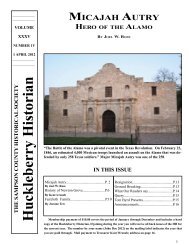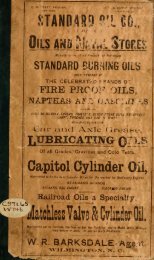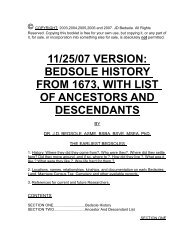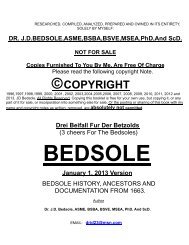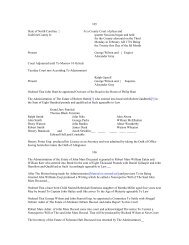Bedsole History from 1673 With Documentation - NCGenWeb
Bedsole History from 1673 With Documentation - NCGenWeb
Bedsole History from 1673 With Documentation - NCGenWeb
You also want an ePaper? Increase the reach of your titles
YUMPU automatically turns print PDFs into web optimized ePapers that Google loves.
Beaufort, County. Ending at Brunswick County, near the state line with South Carolina, the fan-shaped<br />
movement is a familiar and predictive one when you are reviewing first settlements of new places. Reading<br />
about NC in general and Bath County in particular, I found that repeated Yellow Fever epidemics and fierce,<br />
barbaric, antagonistic and warlike indian tribes in and around NC and especially Bath back then, without law<br />
or military protection,were also good reasons for these early arrivals to move and to move frequently.<br />
However, the fact that original counties were subdivided and other counties created <strong>from</strong> them, also<br />
erroneously gives the impression people were moving, when the truth is, the subdivisions were occurring<br />
instead.<br />
As you will see, documentation on Abraham, Elizabeth and Rose, ceased to exist after their arrival at Bath in<br />
May, 1701 and until their arrival in Virginia. That fact created a problem in determining who the subsequent<br />
children of Abraham and Rose actually were. Their son William appeared on paper in Russell County,<br />
Virginia in the form of a handwritten land deed in 1719. Abraham and William both appeared the next time, in<br />
Spotsylvania County, Virginia in 1726, on a land record for 1,000 acres. Their last names were written on<br />
those land records as Bledsoe. The logical reason for that is that all record-keepers were English, and they<br />
wrote and spelled names they were familiar with, and since Bledsoe was in England as far back as the year<br />
1061 and perhaps earlier, they were very familiar with that spelling and freely assigned that spelling to<br />
anyone pronouncing their name even remotely like "Bledsoe" or "<strong>Bedsole</strong>". In Virginia, the trail became very<br />
muddled, with the appearance of several apparently bonified Bledsoe's, who became mixed with bonafide<br />
<strong>Bedsole</strong>s. Then, due to english Scribes, their last names were freely interchanged among them all. Some<br />
were changed deliberately by the persons being named. After all, no form of identification nor records of such<br />
existed.<br />
After that, the efforts to keep track and definition of the bonified <strong>Bedsole</strong>'s and the bonified Bledsoe's<br />
required quadrupling of time, efforts, research., study and analyses. All that required quadrupling again after<br />
they all had sons whom they named after themselves, each other, their uncles, parents and grandparents. It<br />
all became a royal mess, keeping track of who was whom. Through extensive use of the "Most Likely"<br />
research method, I did decide who was whom, as related to Abraham, at least to a point, thus producing the<br />
List Of Names in the second half of this book.<br />
THE CONFUSION OF BEDSOLE AND BLEDSOE SURNAMES<br />
According to Bob Bledsoe, the apparent expert Bledsoe surname researcher, the first Bledsoe here arrived<br />
about 1650 <strong>from</strong> England, which is 50 years prior to the arrival of our first <strong>Bedsole</strong>, <strong>from</strong> Germany. That<br />
defines two distinctly different lines with similar surnames. However, I have been to Germany and I know that<br />
at some point in the past, Bledsoe and <strong>Bedsole</strong> had a common ancestor, most likely in Prussia. But that point<br />
is moot in my opinion, because in this country we are talking about two separate lines which nevertheless<br />
became intermingled here. From the start to current times, the North Carolina, Alabama, Tennessee,<br />
Georgia, Louisiana and Texas Census data repeatedly show Bledsoe's and <strong>Bedsole</strong>'s living among each<br />
other and when one moved, the others either went with them, or shortly afterwards, to the same place. That<br />
indicates to me that most, or at least many, <strong>Bedsole</strong>s and Bledsoes were either related or were freely using<br />
each others last name(s), or both. A very major problem caused by all that uncertainty, was the inability to<br />
determine with any degree of certainty in most cases, if the "<strong>Bedsole</strong>" being researched was really a <strong>Bedsole</strong><br />
or Bledsoe. And that is something which one must frequently decide without much or any, additional<br />
information. On the List in Part Two, if the <strong>Bedsole</strong> in question had decided to use Bledsoe and I knew that, I<br />
listed them as Bledsoe, but kept them on the <strong>Bedsole</strong> list because they actually were <strong>Bedsole</strong>s.<br />
Another research problem for example, was when a "John <strong>Bedsole</strong>" was listed on the 1790 Census' for



